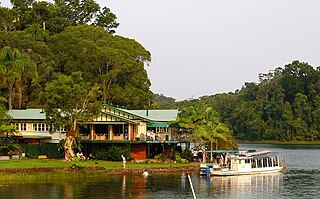
Esk is a rural town and locality in the Somerset Region in South East Queensland, Australia. In the 2021 census, the locality of Esk had a population of 1,641 people.

Palmwoods is a rural town and locality in the Sunshine Coast Region, Queensland, Australia. In the 2021 census, the locality of Palmwoods had a population of 6,357 people.

Tewantin is a town and locality in the Shire of Noosa, Queensland, Australia. Tewantin was the original settlement in the Noosa region and is one of its three major centres today. In the 2021 census, the locality of Tewantin had a population of 11,164 people.

Fitzroy Island is a continental island offshore from Cape Grafton, 29 km southeast of Cairns, Queensland, Australia. It is a locality in the Cairns Region. In the 2021 census, Fitzroy Island had a population of 85 people.

Rainbow Beach is a coastal rural town and locality in the Gympie Region, Queensland, Australia. In the 2016 census, Rainbow Beach had a population of 1,249 people.

Noosa North Shore is a coastal rural locality in the Shire of Noosa, Queensland, Australia. In the 2021 census, Noosa North Shore had a population of 253 people.

Como is a rural locality in the Shire of Noosa, Queensland, Australia. In the 2021 census, Como had a population of 54 people.

Tin Can Bay is a coastal town and locality in the Wide Bay–Burnett region in Queensland, Australia. The locality is split between the Fraser Coast Region and the Gympie Region, but the town itself is within Gympie Region. In the 2016 census, Tin Can Bay had a population of 2,242 people.
Kybong is a rural locality in the Gympie Region, Queensland, Australia. In the 2021 census, Kybong had a population of 363 people.

Geham is a rural locality in the Toowoomba Region, Queensland, Australia. In the 2021 census, Geham had a population of 470 people.

Southern Moreton Bay Islands is an island group locality in the north-east of the City of Gold Coast, Queensland, Australia. In the 2021 census, Southern Moreton Bay Islands had no people.
Cooloola Cove is a coastal locality in the Gympie Region, Queensland, Australia. In the 2021 census, Cooloola Cove had a population of 2,921 people.

The Cooloola Tramway is a heritage-listed tramway at Great Sandy National Park, Cooloola Recreation Area, Cooloola, Gympie Region, Queensland, Australia. In the 1870s it was known as the Kaloola Railway. It is also known as Cooloola Railway, SEQ-5N 22, Pettigrew's Railway, and Pettigrew's Tramway. It was added to the Queensland Heritage Register on 12 July 2013.

Qunaba is a rural locality in the Bundaberg Region, Queensland, Australia. In the 2016 census Qunaba had a population of 793 people.
Bunya Mountains is a locality split between the Western Downs Region and the South Burnett Region, Queensland, Australia. The town of Mount Mowbullan is located on the boundary of Bunya Mountains and the enclosed locality of Mowbullan. In the 2016 census, Bunya Mountains had a population of 144 people.

Fairymead is a coastal locality in the Bundaberg Region, Queensland, Australia. In the 2021 census, Fairymead had a population of 28 people.

Lake Barrine is a rural locality in the Tablelands Region, Queensland, Australia. In the 2021 census, Lake Barrine had a population of 170 people.
Tinnanbar is a coastal town and a locality in the Fraser Coast Region, Queensland, Australia. In the 2016 census, Tinnanbar had a population of 123 people.
Germantown is a rural locality in the Cassowary Coast Region, Queensland, Australia. In the 2021 census, Germantown had a population of 52 people.














